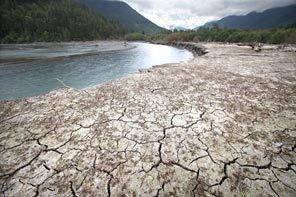Originally published Saturday, September 17, 2011 at 7:00 PM
Huge masses of sediment mean dams must be removed chunk by chunk
The pace and method of taking out two dams on the Elwha River will be largely set by the enormous load of sediment backed up behind them: 24 million cubic yards, more than ever attempted in a controlled sediment release anywhere in North America.
Seattle Times staff reporter
STEVE RINGMAN / THE SEATTLE TIMES
Dam removal will allow the Elwha to once again transport sediment from the high mountains to the sea, a process that maintains the river's natural form and function. Here, the Elwha in July slices through sediment exposed as reservoirs were drained to prepare for dam removal. It's just a fraction of the 24 million cubic yards of trapped sediment that must be managed by controlling the pace of dam removal.

THE DAMS
Story: An unprecedented restoration effort
THE HISTORY
Timeline: An Elwha River chronology
Video: Building dams, powering the economy
THE SALMON
Story: Will giant chinook salmon return?
Graphic: The five species of Elwha salmon
THE TRIBE
Story: The ancestors' prayers answered
Video: A talk with elder Adeline Smith
REVEGETATION
Story: Restoring a healthy watershed
THE SEDIMENT
Story: Biggest-ever sediment release
Graphic: Picturing 24 million cubic yards
CHAT REWIND
Behind the scenes of the Elwha special report
PROJECT HOME
![]()
Taking the dams out on the Elwha River is the easy part — it's getting rid of the sediment behind them that's hard.
More than 24 million cubic yards of silt, sand, gravel and cobble are impounded behind the dams. That's enough to fill 10 Kingdomes.
Sediment may sound dull, but getting it downriver in the right way is what's driving the schedule and method of dam removal on the Elwha. Nothing comparable has been attempted before in North America. Marmot Dam on the Sandy River in Oregon was one of the biggest dam takedowns in the U.S., in 2007, but it was puny by comparison — just 47 feet high, with about 1 million cubic yards of sediment behind it.
Marmot came down in just four months — and with the cathartic ka-boom of dynamite detonating the face of the dam to get it all started.
But this takedown mostly will be a chunk-by-chunk deconstruction, drawing down the reservoirs behind both dams simultaneously as a crane lifts chunks of sawed-out concrete. The reservoirs already have been drawn down to the dams' spillway crest. Now it's time to start taking down the structures and letting the rest of the water out. Getting the pace of dam removal right is critical.
Too fast, and the water will sluice through the impounded sediment like a hot knife through butter, cutting a slot that leaves giant cliffs — an unnatural-looking, unstable landscape. The risk of landslides into the reservoirs could increase. Sending a big slug of sediment downstream also could overwhelm water-treatment plants.
But let the water out too slowly and the river won't have the energy it needs to carry all that sediment downriver. Leaving too much sediment behind could raise the river bed, increasing the risk of flooding.
There are bound to be surprises: Buried log jams in the muck, even possibly standing forests, long drowned in the reservoirs, could affect the flow.
Reservoir drawdown is the gas pedal on the process. Drawdown creates the gradient that makes the river work to get downslope to the sea. Increase the gradient, and the river will work harder, faster — taking the sediment with it.
If erosion is happening too quickly and sediment loads in the river are too high, engineers can stop the drawdown, to release the river's bite. That's the plan, anyway, arrived at through years of modeling and preparation led by the U.S. Bureau of Reclamation.
Nearly half the year, drawdown will be stopped altogether to reduce harm to fish when they are migrating in the river.
Success, if it occurs, looks like this: getting out all the sediment that's coming out before dam removal is over, leaving a series of stepped-down terraces that will be revegetated over time. Success also means letting the river act as a conveyor belt once again, powered by the hydrologic cycle, as rain and snow erode the mountains, and the river carries them grain by grain and rock by rock to the Strait of Juan de Fuca.
Dam removal will allow the river to transport sediment throughout its reach, helping to rebuild the natural bed structure and flow of the Elwha.
Will it work? About 600 dams have been taken down in the U.S. over the past 50 years, but none involved so much sediment. "You kind of have a tiger by the tail," said Tim Randle, leading the Elwha removal project for the bureau. "And the only knob you can turn is how quickly you take it down."
Staff researcher Gene Balk contributed to this story.
















